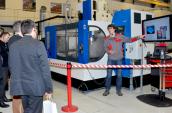Metal Processing
Headlines

The tremendous development of cryogenic machining driven by the “Dry to fly” project
The aim of the “Dry To Fly” project is to reduce the production costs of large-sized parts. Two years after the project started, the cryogenic-assisted milling demonstrators for materials known for being difficult to machine, are giving their first results.
Dry-to-Fly” is now fully entering its practical implementation phase. This industrial project launched in 2015 is aimed at decreasing large part production costs by more than 30%, mainly in such fields as aeronautics, aerospace, energy (nuclear, wind, oil energy, etc.), and transport (rail, maritime/naval transport, etc.). For this purpose, three avenues are being studied: preparation of the material through an innovative 3D cutting system, new machining strategies with the elimination of the CAM, replaced with Stratodesign algorithms (solid/solid-type additive manufacturing process), adaptive control and cryogenic machining assistance. The latter field is that in which the project has mostly progressed – three cryogenic-assisted milling demonstrators have been made, including one installed in Cetim’s premises and unveiled to the public during the Intercut days (see photo), on 1 and 2 February 2017 in Senlis (France).
Machining at -200°C
Cryogenic assistance consists in avoiding overheating phenomena by cooling the part and the tool as close as possible to the cutting area with liquid nitrogen whose temperature is approximately - 200°C. This technique is intended for materials with high mechanical characteristics usually used for parts which are often complex, subjected to high loads, and known to be difficult to machine. For instance, the TA6V titanium alloy has low thermal conductivity (6 times less conductive than steel) and a specific high cutting coefficient. Consequently, the productivity and service life of cutting tools are significantly reduced in conventional machining configuration, with soluble-oil lubrication.
There are substantial difficulties, particularly for milling operations, during which nitrogen should circulate inside the cutting tool, thus, inside the pin, and reach tool end at liquid state. But it works! For the TA6V milling, the first test conducted on Cetim’s demonstrator reveal that the cutting speed and the swarf output have almost doubled, compared with conventional machining. Furthermore, the surface integrity of the part is preserved and results regarding compliance with tolerance are promising.
The “Dry To Fly project, supported by Mécachrome, an industrial manufacturer located in Amboise (Indre-et-Loire, France), includes Cetim, Cirtes, Evatec Tools, Inori SAS, Missler Software and MPM (Meyer France Group). The project, with a EUR 12.5-million budget, has been approved by the Materalia, Viameca and EMC2 competitive clusters. It started in January 2015, for a term of 4 years.
Other informations
A whole week of testing for future training technologies
Headlines
From 22 to 26 March 2021, new learning tools were assessed under real conditions in the Hauts-d...
Video: Cetim takes up the challenge of metal additive manufacturing
Headlines
In a new video, Philippe Lubineau, Chief Research Officer at Cetim, talks about this key techno...
Video: “I am Sure” project monitors metal additive manufacturing
Headlines
detection of incipient defects reveals its results in a new video. The “I am Su...
Scientific publications
- Galling detection by acoustic emission according to ASTMG98
- Thermomechanichal study of high speed rolling element bearing: a simplified approach
- Robust Active Control of The Milling Process Vibrations in a fixed reference frame
- 3D numerical simulation of drilling residual stresses
- Influence of the lubrication conditions on surface integrity in drilling
References
Fault analyses completed in double quick time
( Locapal)Test protocols tailored to each implant
( Newclip Technics)Acceptance of a key Vulcain 2.1 engine component
( ArianeGroup)Assistance in automated polishing
( Chapuis Armes)Better characterize the powders to better use them
( Chpolansky)Results of studies
ASME Boiler and Pressure Vessel - Code Week Meetings - November 2019 - Version Anglaise
Dimensioning of form tapping – Phase 3
Feasibility study of the multi-directional forging technology - PHASE 2
Material fatigue - Factors influencing the fatigue strength of metal of metal materials
Additive manufacturing of hot-forging tooling
Presentation
Deeply touched by crisis, this industry can rely on the various skills offered by Cetim to reinforce its competitiveness.
Innovation, product ranges redesign, process or organizational expertise... Cetim suggests you alternative solutions and takes part in supporting this essential-to-the-industrial-production market.





